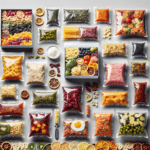The grid goes down. Grocery stores are emptied in hours. If you don’t already have emergency food stored, what will you eat? In 2025, with climate events, supply chain issues, and global uncertainty, emergency food storage isn’t just smart — it’s essential. But not all preserved foods are created equal. Let’s unpack the real differences between freeze-dried and dehydrated foods and find out which one deserves space in your survival pantry.
Why Emergency Food Storage Matters
Having a reliable supply of food during emergencies buys you peace of mind. It eliminates panic and ensures your family stays nourished when daily luxuries disappear. Preservation methods play a massive role in how effective your food supply will be during critical times.
Freeze-drying and dehydration are two popular methods. Each has strengths, weaknesses, and ideal uses, and understanding them can be the difference between a thriving pantry and one that falls short when needed most.
How Freeze-Drying Works
The Freeze-Drying Process Explained
Freeze-drying is a high-tech marvel that preserves food by removing moisture through a sophisticated three-step process. First, the food is frozen solid to lock in its structure and nutrients. Next, a powerful vacuum is applied to reduce pressure.
The magic happens during sublimation, where ice turns directly into vapor without becoming liquid. This delicate method preserves the food’s cellular integrity, resulting in lightweight, shelf-stable products.
Common Foods That Are Freeze-Dried
Fruits like strawberries, bananas, and blueberries dominate the freeze-dried world, along with full meals, meats, and even dairy products. Ice cream sandwiches popular with campers? Freeze-dried.
Key Characteristics of Freeze-Dried Foods
Freeze-dried foods are feather-light, crisp, and almost eerily preserved. They retain their original shape, color, and often taste exactly as they did fresh after rehydration, making them highly desirable for both emergency storage and daily convenience.
How Dehydration Works
Steps in the Dehydration Process
Dehydration has been practiced for thousands of years and remains a reliable preservation method. It uses low heat and consistent airflow to slowly draw out moisture. The key is patience and steady temperatures to avoid cooking rather than drying the food.
Over time, water content plummets to levels that inhibit bacterial growth and mold, turning perishables into shelf-stable foods.
Common Foods That Are Dehydrated
Think beef jerky, dried apples, sun-dried tomatoes, and herbs. Dehydrated staples are easy to make at home with a simple dehydrator, oven, or even by air-drying in arid environments.
Key Characteristics of Dehydrated Foods
Dehydrated foods are denser and often darker in color. They shrink significantly in size and weight but don’t reconstitute to the same fresh-like texture as freeze-dried counterparts.
Nutritional Comparison
Retention of Vitamins and Minerals
Nutrient retention is critical for emergency foods. Freeze-drying excels here, preserving around 90-95% of nutrients according to research by the USDA. Dehydration, by contrast, leads to losses of up to 50% of vitamin C and notable degradation of B vitamins due to the heat.
As quoted by Dr. Diane Barrett, food scientist at UC Davis, “Freeze-drying is one of the best methods for preserving both nutritional quality and food palatability.”
Impact on Calorie and Protein Content
Calories and proteins remain mostly intact in both processes. However, delicate micronutrients can take a bigger hit during dehydration. For long-term nutritional balance, freeze-dried foods may offer a slight advantage.
Flavor and Texture Differences
Freeze-dried foods maintain superior flavor and a crisp, airy texture. Dehydrated foods often turn chewy or leathery, with more intense, sometimes altered flavors due to concentration.
Shelf Life and Long-Term Storage
Expected Shelf Life: Freeze-Dried vs. Dehydrated
Freeze-dried foods can boast shelf lives of 25 to 30 years under ideal conditions. Dehydrated foods typically last 5 to 15 years depending on the product and storage.
Storage Conditions and Packaging Requirements
Both preservation types demand cool, dark, and dry environments. Freeze-dried foods often come sealed in mylar bags with oxygen absorbers. Dehydrated foods need airtight containers like mason jars or vacuum-sealed bags.
Signs of Spoilage and How to Check for Product Integrity
Check for moisture intrusion, strange odors, color changes, or mold. If any of these appear, consume the product at your own risk — spoilage can set in long before visible signs emerge.
Cost and Availability
Price Difference Between Freeze-Dried and Dehydrated
Freeze-dried foods are significantly more expensive. Expect to pay two to three times more per ounce compared to dehydrated options.
Factors Influencing Cost
Higher costs in freeze-dried foods stem from expensive equipment, longer manufacturing times, and specialty packaging. Brand reputation and organic certifications can also drive up prices.
Where to Source Bulk and Individual Products
Major suppliers like Mountain House, Augason Farms, and Thrive Life offer bulk freeze-dried foods. Dehydrated foods are available at Costco, Amazon, or through DIY methods using home equipment.
Ease of Use and Preparation
Cooking and Rehydration Processes
Freeze-dried meals often require nothing more than hot water. Dehydrated foods sometimes need simmering for optimal texture.
Water Requirements for Rehydration
Freeze-dried foods rehydrate quickly with less water, a critical advantage during water-scarce emergencies. Dehydrated foods absorb more water and take longer to plump up.
Practical Tips for Meal Planning
Mix freeze-dried meats with dehydrated veggies to stretch meals economically. Always plan for enough clean water as part of your survival supplies.
Suitability in Various Emergency Scenarios
Short-Term Emergencies vs. Long-Term Survival
For short-term crises, dehydrated foods shine for their affordability and flavor density. For multi-month or multi-year scenarios, freeze-dried foods offer irreplaceable shelf life and nutritional advantages.
Space Constraints and Transportability
Freeze-dried food, being more voluminous but lighter, is excellent for bug-out bags. Dehydrated foods, due to their compactness, excel in small-space storage plans.
Balancing Nutrition with Convenience
Striking a balance between freeze-dried and dehydrated foods ensures both price-consciousness and optimal nutrition. You don’t have to choose one over the other.
Pros and Cons of Freeze-Dried Foods
Advantages
- Exceptional shelf life of 25-30 years.
- Retains original flavor, nutrition, and appearance.
Disadvantages
- Higher upfront cost.
- Bulky packaging takes up more space.
Pros and Cons of Dehydrated Foods
Advantages
- Budget-friendly and widely available.
- Easier to make at home with basic equipment.
Disadvantages
- Typically 5-10 years of shelf life.
- Nutrient loss during the drying process.
Making the Right Choice for Your Emergency Supply
Factors to Consider
Budget, storage space, taste preferences, and length of expected emergency scenarios should shape your choices. Prioritize according to your personal needs.
Combining Freeze-Dried and Dehydrated Options
A hybrid pantry is a well-rounded pantry. Use dehydrated staples for daily use and save freeze-dried items for critical, long-haul emergencies.
Recommended Ratios for a Balanced Stockpile
Aim for a 60/40 or even 70/30 split favoring dehydrated foods for affordability, backed by freeze-dried goods for longevity and nutrition insurance.
Additional Tips for Safe Storage
Proper Sealing and Oxygen Absorbers
Invest in quality mylar bags, vacuum sealing, and oxygen absorbers to maximize storage life and food safety.
Rotating Supplies to Maintain Freshness
Adopt the “first in, first out” (FIFO) method. Rotate stock regularly, especially with dehydrated foods that have a shorter lifespan.
Monitoring and Record-Keeping
Keep an updated inventory list with purchase dates and expected expiry points. Monitoring helps prevent costly waste down the road.
Conclusion and Key Takeaways
Freeze-dried foods offer superior shelf life and nutrient retention at a higher cost, while dehydrated foods bring affordability and practicality into play. Each method serves a vital role depending on your survival strategy.
For a truly resilient and dependable food storage system, combine both freeze-dried and dehydrated foods wisely. Prepare now so you won’t have to panic later — your future self will thank you.







